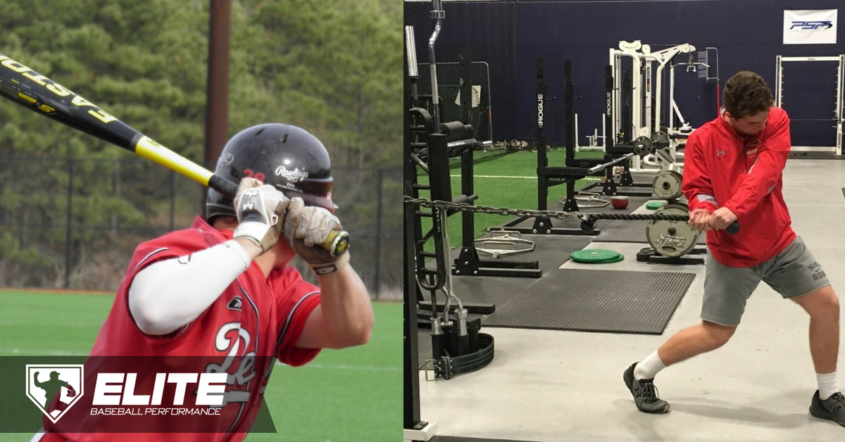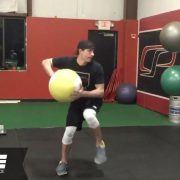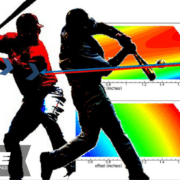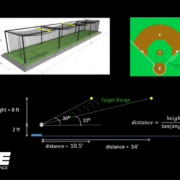Research Review: Weighted Implements and Swing Velocity
Hitting success in the game of baseball can be classified with three distinct factors: decision time, swing velocity, and exit velocity.
Since exit velocity can be influenced by the first two factors, is there a way we can enhance swing velocity before stepping into the batter’s box?
Previous researchers have tried to determine if swinging a slightly lighter or slightly heavier bat can enhance swing velocity.
Decision time and swing velocity have an inverse relationship: having more time to decide in swinging the bat will need a quicker swing velocity.
In this present study, subjects performed a swinging warm up with either a lighter plastic bat, normal game bat, or a significantly heavier bat.
The results showed that there were no significant differences in swing velocity before the swing intervention.
However, after the different swing warm ups, the plastic bat seemed to increase swing velocity post-warm up, with no significant difference from the normal game bat.
Adding to the body of research, this study shows that swinging a heavier bat can decrease swing velocity.
Although this new information adds to the body of research, the subjects rested for 2-3 minutes between their warm up trial, which may not be enough time in a normal game situation.
Previous research determined that swinging a bat within a 10% range of your normal game bat can still enhance swing velocity without altering swing mechanics. The heavy bat used in this study was almost 200% greater in mass!
If you want to optimize your swing velocity in the batter’s box, it is recommended to use a bat that you are comfortable with. A significantly heavier bat may decrease your swing velocity, so it’s important to stay within the 10% range of your normal game bat.
Evaluating the effects of underloaded and overloaded warm ups on subsequent swing velocity.
Several attempts to identify the optimal on deck procedure to enhance swing velocity in baseball have been made. However, inconsistent findings continue to constitute much of the body of literature. Additionally, the emergence of athlete monitoring in sport has led to the exploration of more sport specific tasks to potentially identify athlete fatigue and readiness to perform. Therefore, the purpose of this investigation was to examine three different bat weight warm up protocols on subsequent swing velocity and to examine the reliability of swing velocity measurements to allude to its potential a sport specific athlete monitoring metric. Thirty-two recreational male baseball players (20.3 ± 2.0years, 179.6 ± 7.1cm and 89.6± 11.1kg) completed the study. Subjects completed three testing visits that included warming up with a control bat ([CB] 32in, 29oz), plastic bat ([PB] 31in, 6.4oz), or heavy bat ([HB] 32in, 57oz). Testing visits began with three CB swing trials followed by three intervention bat trials, then concluded with three additional CB swings. Swing velocity was assessed using visual 3D technology. Analyses of variance indicate that following the PB (26.6 ± 2.0m/s) and CB interventions (26.2 ± 1.7m/s) significantly faster (p<0.001) swing velocities were generated when compared to the traditional HB intervention (24.1 ± 2.2m/s). When assessed for reliability, the average ICC was 0.681 and Chronbach’s alpha was 0.95 indicating exceptional reliability. Congruent to previous research, this data bolsters the notion that warming up with a HB can hinder swing velocity. However, in contrast to previous research this data suggests that using a PB can increase swing velocity significantly. Furthermore, visual 3D can be designated as an exceptionally reliable device to measure swing velocity.
Jarad Vollkommer
Latest posts by Jarad Vollkommer (see all)
- Strength-Speed: Customized Mechanics for Baseball Pitchers - August 20, 2019
- Determining Individual Stability Needs for the Baseball Player - June 25, 2019
- In-Season Training Metrics for the Baseball Player - March 5, 2019










Trackbacks & Pingbacks
[…] are many, many studies (here, here, and here) stating that the donut does not improve your swing velocity, it actually does the opposite. Well, […]
Leave a Reply
Want to join the discussion?Feel free to contribute!